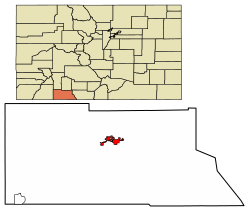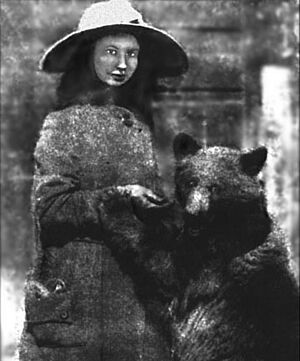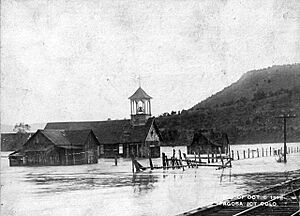Pagosa Springs, Colorado facts for kids
Quick facts for kids
Pagosa Springs, Colorado
|
|
|---|---|

Aerial view of west Pagosa Springs
|
|

Location of Pagosa Springs in Archuleta County, Colorado.
|
|
| Country | |
| State | |
| County | Archuleta County Seat |
| Incorporated (town) | March 18, 1891 |
| Government | |
| • Type | Home rule municipality |
| Area | |
| • Total | 5.06 sq mi (13.10 km2) |
| • Land | 5.03 sq mi (13.04 km2) |
| • Water | 0.03 sq mi (0.07 km2) |
| Elevation | 7,110 ft (2,170 m) |
| Population
(2020)
|
|
| • Total | 1,571 |
| • Density | 310.5/sq mi (119.92/km2) |
| Time zone | UTC-7 (Mountain (MST)) |
| • Summer (DST) | UTC-6 (MDT) |
| ZIP Codes |
81147, 81157 (PO Box)
|
| Area code(s) | 970 |
| FIPS code | 08-56860 |
| GNIS feature ID | 2413099 |
Pagosa Springs (in Ute language: Pagwöösa, in Navajo language: Tó Sido Háálį́) is a town in Colorado, United States. It is the main town and county seat of Archuleta County. In 2020, about 1,571 people lived there. A large part of Archuleta County is covered by national forests, wilderness areas, or the Southern Ute Indian Reservation.
Pagosa Springs is located about 35 miles (56 km) north of the New Mexico border. It sits high up, about 7,126 feet (2,172 meters) above sea level. The town is on the Western Slope of the Continental Divide. This area combines high desert with the Rocky Mountains to the north and east. This mix creates a very mild climate, especially in the summer. Pagosa Springs gets around 300 sunny days each year and experiences all four seasons.
The town is in the upper San Juan Basin. It is surrounded by the huge San Juan National Forest. It is also next to the Weminuche Wilderness, which is the largest wilderness area in Colorado.
Pagosa Springs is famous for its special sulfur hot springs. These include the world's deepest geothermal hot spring. The main "Mother" spring feeds both natural and developed hot spring pools. These pools are found along the banks of the San Juan River, which flows through the town. The natural springs can be accessed by the public. However, their water is usually too hot to enter safely. Developed springs feed soaking pools at three private locations in town. The water from the "Mother" spring is about 144°F (62°C).
Contents
History of Pagosa Springs
Early History of the Hot Springs
Local Native American people used the hot springs for many centuries. They considered the area to be "sacred ground." In the beliefs of the Navajo people, Pagosa Springs is where they came into this world from an underground world. In 1859, a white settler "discovered" the springs. Later, in 1881, the first bathhouse was built there for people to pay and use the springs.
The Ute people called the sulfur-rich mineral springs Pah gosah. This name is often translated today as "healing waters." However, some Ute elders have said it means "water (pah) that has a bad smell (gosah)." The Archuleta County government says "pagosa" means "healing" or "boiling water."
After the American Civil War, the U.S. government thought about building a hospital in Pagosa Springs. This hospital would have been for soldiers recovering from injuries. But the plan was canceled. The land was then sold to private owners. These owners used the hot springs to create businesses. Simple wooden bathhouses were built along the San Juan River.
In the late 1880s, Dr. Mary Winter Fisher moved from Chicago to Pagosa Springs. She started a medical and healing practice there. Today, the medical center in town is named after her.
Modern Development of the Springs
In the 1930s, a woman named Cora Woods built a geothermal swimming pool. She also built several small cabins on land she bought. There were 23 cabins in total. They had no electricity, dirt floors, wood stoves, and iceboxes. In the 1950s, the Giordano family bought the property. They were coal miners from Europe. They dug more geothermal wells. They also built an indoor bathhouse next to the swimming pool.
In the 1980s, Pagosa Springs received money from the Department of Energy. This money was used to drill two geothermal wells. These wells helped heat buildings in the downtown area. In the 1990s, the town built a new pipeline and a bridge. This helped deliver mineral spring water to a new resort.
The 1911 Flood
On October 5, 1911, a big flood happened in Archuleta County. The flood destroyed the town's water supply pipeline. It also destroyed all the bridges in the county, including those over the San Juan River. A cable was set up across the river. This helped people cross and allowed food to be delivered to those who were stuck. Many buildings were damaged or destroyed, including the electric plant. Train service and mail delivery stopped because the train tracks were washed away.
Geography and Climate
Where is Pagosa Springs?
Pagosa Springs is located about 47 miles (75 km) east of Durango. The San Juan River flows right through the middle of the town. The area around Pagosa Springs has many large waterfalls. One example is Treasure Falls, which is east of town off Highway 160. It is just past the Wolf Creek Pass summit.
Pagosa Springs Climate
| Climate data for Pagosa Springs, CO (2000-2015 normals) | |||||||||||||
|---|---|---|---|---|---|---|---|---|---|---|---|---|---|
| Month | Jan | Feb | Mar | Apr | May | Jun | Jul | Aug | Sep | Oct | Nov | Dec | Year |
| Mean daily maximum °F (°C) | 37.9 (3.3) |
42.6 (5.9) |
49.2 (9.6) |
59.2 (15.1) |
68.3 (20.2) |
78.3 (25.7) |
83.1 (28.4) |
80.7 (27.1) |
74.3 (23.5) |
63.7 (17.6) |
49.7 (9.8) |
39.6 (4.2) |
60.6 (15.9) |
| Mean daily minimum °F (°C) | 1.4 (−17.0) |
7.0 (−13.9) |
15.9 (−8.9) |
23.9 (−4.5) |
30.2 (−1.0) |
36.3 (2.4) |
45.2 (7.3) |
44.6 (7.0) |
36.6 (2.6) |
26.3 (−3.2) |
15.4 (−9.2) |
5.0 (−15.0) |
24.0 (−4.4) |
| Average precipitation inches (mm) | 1.97 (50) |
1.42 (36) |
1.60 (41) |
1.36 (35) |
1.20 (30) |
0.95 (24) |
1.88 (48) |
2.52 (64) |
1.85 (47) |
2.29 (58) |
1.39 (35) |
1.78 (45) |
20.22 (514) |
| Average snowfall inches (cm) | 26.4 (67) |
18.9 (48) |
15.1 (38) |
5.5 (14) |
0.9 (2.3) |
0 (0) |
0 (0) |
0 (0) |
0.1 (0.25) |
3.2 (8.1) |
10.0 (25) |
21.2 (54) |
101.5 (258) |
Population and Education
How Many People Live Here?
| Historical population | |||
|---|---|---|---|
| Census | Pop. | %± | |
| 1880 | 223 | — | |
| 1900 | 367 | — | |
| 1910 | 669 | 82.3% | |
| 1920 | 1,032 | 54.3% | |
| 1930 | 804 | −22.1% | |
| 1940 | 1,591 | 97.9% | |
| 1950 | 1,379 | −13.3% | |
| 1960 | 1,374 | −0.4% | |
| 1970 | 1,360 | −1.0% | |
| 1980 | 1,331 | −2.1% | |
| 1990 | 1,207 | −9.3% | |
| 2000 | 1,591 | 31.8% | |
| 2010 | 1,727 | 8.5% | |
| 2020 | 1,571 | −9.0% | |
Schools in Pagosa Springs
The public schools in Pagosa Springs are run by the Archuleta County School District 50-JT. Pagosa Springs High School is the main high school for the community.
Fun Things to Do
There are many fun things to do in the Pagosa Springs area. In winter, people enjoy downhill and cross-country skiing at the nearby Wolf Creek ski area. Snowmobiling is also popular in the surrounding National Forest. In summer, activities include fishing, hiking, and rafting. The area is also a favorite spot for hunters, who hunt elk, deer, and other game animals.
Famous People from Pagosa Springs
- Dan Fogelberg, an American singer and songwriter, lived on a ranch near Pagosa Springs. He had his recording studio there.
- Ursala Hudson (Tlingit), a famous weaver of Chilkat and Ravenstail blankets.
- Frank Oppenheimer, an American particle physicist, cattle rancher, and professor.
See also
 In Spanish: Pagosa Springs para niños
In Spanish: Pagosa Springs para niños




